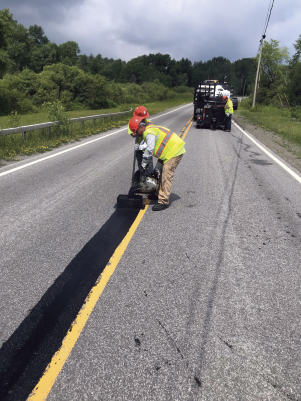Upstate New York winters are the stuff of legend—no more so than in Syracuse, which averages over 115 inches of snow each year, the most of any U.S. metro area. With the pounding of snow plows, deicing materials, studded tires, and months of freeze/thaw conditions, the region’s roads take a beating.
Just ask the Madison County Highway Department, which is responsible for more than 434 miles of roads and 124 bridges. Most of the county’s roads are asphalt, rural and low volume, with plenty of hills and curves. To keep those roads safe and smooth, crews must find and fix cracks and potholes before they get bigger. And to keep themselves safe in the process, crews must work quickly so they spend less time in the path of vehicles rounding a curve or cresting a hill.
“A lot of these cracks were just too large to use typical crack fill material, and we would have issues at those locations,” says Brad Newman, project engineer and deputy highway superintendent. “There was definitely a need between crack filling and shimming. There was a gap where we needed something for these larger size cracks.”
CUTTING COSTS WITHOUT CUTTING CORNERS
That gap was finally filled when a rep from The Gorman Group, an Albany, New York-based road materials supplier, introduced Newman and his team to Crafco Mastic One. Used successfully by highway departments across the country for more than 20 years, Crafco Mastic One is designed for pavement cracks over 1.5 inches wide and other distressed surface areas that can’t be repaired effectively with hot mix asphalt.
Mastic One is a pourable, hot-applied, highly adhesive, flexible asphalt binder with selected aggregate to ensure a permanent repair with excellent load-bearing characteristics. Mastic One is designed to bond to both asphalt cement concrete and Portland cement concrete pavements, making it ideal for virtually any type of application, from country two-lanes to urban interstates.
“We have been using Mastic One for about three years,” says Rick Jasewicz, a Gorman Group supervisor. “The application was to repair numerous areas of spalling, alligator cracking and potholes. We used this process to repair these areas before a final surface treatment of chip seal was performed.”

The Gorman Group used a Crafco Patcher II melter, a double-boiler unit that’s specifically designed for mastics. The unit’s digital controls maintain proper material application temperature and mixture to make it easy for the crew and ensure a successful repair. The Gorman group used a 10- to 12-inch Crafco drag box to provide the correct repair width for most of the applications. Available in widths ranging from 4 to 48 inches, Crafco drag boxes are designed to easily move side-to-side so crews can precisely follow cracks and distresses. The ease of application and high production keeps traffic flowing and minimizes the time the crew spends on the road.
“The crew had to meet a production goal without jeopardizing quality of the installation,” Jasewicz says. “The biggest benefit to using this application is unlike crack seal, it will repair multi-cracking areas usually with one drag box instead of multiple, side-by-side crack seal bands.”
For Madison County, there was also a financial benefit. “It reduced overall project cost, labor and material,” Newman says. “Mastic One reduces the overall material usage typically required by our traditional hot mix shimming with our paver by correcting the deficient areas in a more localized manner instead of paving the entire lane or road.”
Additionally, cold patching or hot mix patching isolated potholes requires labor-intensive prep work to be done correctly as compared with the mastic installation. Maximizing productivity and efficiency is always a major plus, but it’s more important than ever as highway departments across the country struggle with the post-pandemic shortage of employees.
“It helped with our paving schedule by limiting the amount of work for our paving crew,” Newman says. “It also saves the crack fill crew [from] going out and refilling some of these larger cracks after they’ve been filled. So, it definitely saves time and money.”
PREP FOR THE LONG HAUL
Proper prep work also helped Madison County ensure successful applications. “One of the things that I’ve learned is you have to go out there and identify the locations where you’re going to be using mastic,” Newman says. “We mark all the locations with spray paint so when the crack fill crew come in, they know to get those spots.”
Crafco Territory Manager Anthony Simone was also on hand to provide technical support. “He’s been out on the jobsite a few times just making sure everything was being done in accordance with their specs,” Newman says.
CLOSING THOUGHT
All of that ensures that Mastic One will be fortifying Madison County roads for years to come. “We typically chip seal over the mastic,” Newman says. “We’ve been trying to do mastic a year in advance of our chip seal. I really haven’t seen any reflective cracking or anything like that, so it’s held up very good.”
About the Author:
For more information about Mastic One, visit www.crafco.com.
Modern Contractor Solutions, October 2023
Did you enjoy this article?
Subscribe to the FREE Digital Edition of Modern Contractor Solutions magazine.


